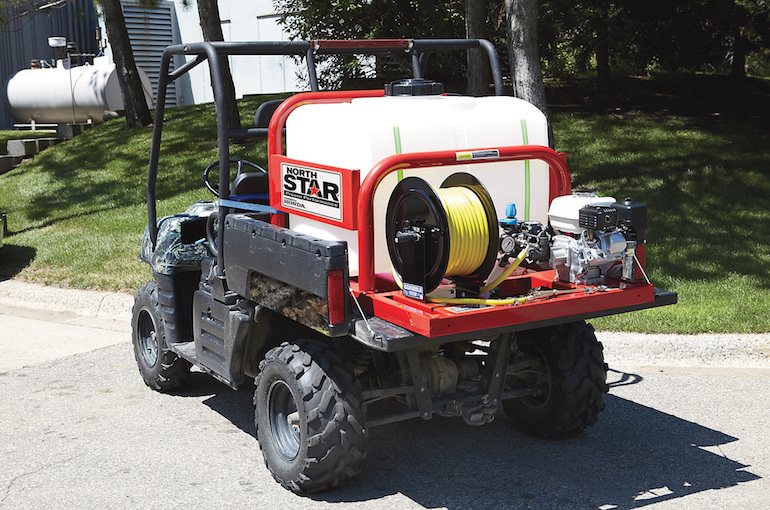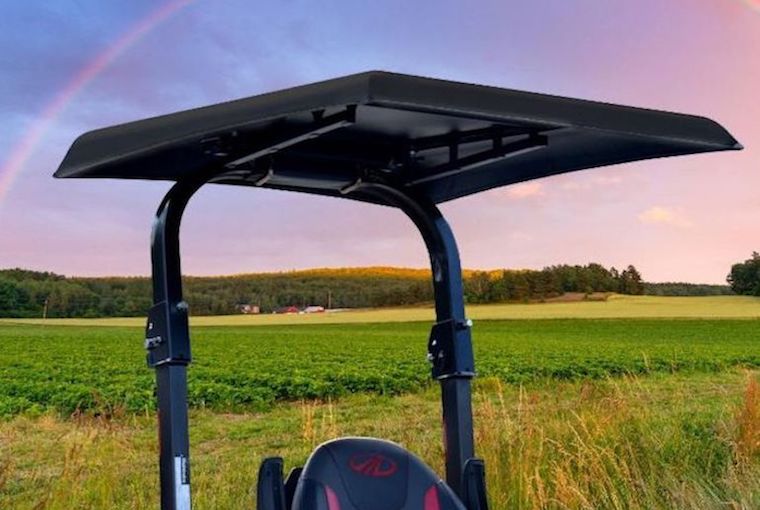
Historic Hotels of America are home to some of the nation’s most magnificent and beautiful storybook gardens. With this in mind, the organization has compiled the 2019 Historic Hotels of America Top 25 Most Magnificent Gardens.
The Inn at Montchanin Village (1799) Montchanin, DE
The Inn at Montchanin Village has a full-time horticulturist and its own off-site greenhouses, which provide exquisite colorful landscaping on the grounds. Plantings help define spaces and create private garden nooks for guests to enjoy. The restaurant at the Inn, Krazy Kat’s, offers dishes with herbs and vegetables grown in the gardens of this historic hotel. Guests can access the historic buildings via a maze of ornate gardens featuring beautiful flowers and fragrant herbs.
Antrim 1844 Taneytown, MD
Located within feet of the mansion and the glass enclosed pavilion is the formal rose garden, enhanced by matching bronze fountains with over 100 varieties of English Tea Roses. Guest can wander into the secluded secret garden that features the ancient branches of a majestic elm tree and provide an enchanted feeling for those who enjoy the beauty of nature. The original formal garden was designed and planted in 1844. Traditional plantings include Boxwood, Peonies, Holly Trees, Azalea, Silver Maple Trees, Jonquils, Tulips, and Cannas. There are more than 50 varieties of English tea roses, with many reaching a height of five feet tall. An herb garden is located beside the hotel’s original ice house, which provides the seasonings for the incredible cuisine from Antrim 1844’s Smokehouse Restaurant.
French Lick Resort (1845) French Lick, IN
French Lick Resort is comprised of two historic hotels, French Lick Springs Hotel, dating back to 1845 and West Baden Springs Hotel, dating back to 1902 and designated a National Historic Landmark by the U.S. Secretary of the Interior. Between both hotels, there are over 40 different varieties of flowering perennials and 17 different varieties of summer annuals used each year. Roughly 11,000 summer annuals are planted throughout many flowerbeds, hanging baskets and planters. Trees, shrubs, perennials, and annuals can be seen in bloom from April-November throughout the resort. Summer annuals are installed by mid-May. Guests can learn more during events hosted at West Baden Springs Hotel including West Baden Gardening Guidance class and Fall into Gardening class. Both are small group experiences led by Todd Schrank, Head Gardener for the resort.
Grand Hotel Golf Resort & Spa (1847) Point Clear, AL

The Grand at Point Clear
More than 70 massive live oak trees dripping in Spanish moss are a highlight of the resort’s lush historic landscape. Each historic oak tree is numbered and receives monthly care for future generations to enjoy. Surrounded by brilliant Southern azaleas, roses, camellias, colorful annuals and lush vegetation, the Grand Oaks are legendary. Countless brides and families have taken portraits under the Grand Oaks. From a secret garden for customized meals for couples, to the chef’s garden with more than 70 kinds of edible plants, Grand Hotel’s gardens include 550 pristine acres featuring a stunning selection of color. The expanded estate garden offers beautiful flowers and fresh ingredients for use by the Grand Hotel’s chefs. However, the Grand Oaks and fresh mint are the most beloved garden elements by guests and add to the resort’s Southern charm. Countless annual and perennial seasonal flowers are added the Grand Hotel’s gardens each year. Many of these appeal to the Monarch butterflies which stop at the Grand Hotel on their way to Mexico each fall.
Nottoway Plantation and Resort (1859) White Castle, LA
Nestled along the banks of the Mississippi River is the majestic Nottoway Plantation. There are 16 live Oaks that are registered with the National Live Oak Society and remain a cherished element of this resort. Many of the trees are as old as 150 years. Events and wedding ceremonies are planned under the canopies of these majestic trees because of the natural beauty of the branches. A working vegetable garden and herb garden is in use by the hotel’s kitchen to complement dishes with fresh ingredients. Abundant varieties of roses are staples used on the grounds at Nottoway, with more than 100 of them planted throughout the grounds.

Mohonk Mountain House
Mohonk Mountain House (1869) New Paltz, NY
The formal ornamental gardens at Mohonk Mountain House, designated a National Historic Landmark by the U.S. Secretary of the Interior, were designed to fit into what was described as ‘the picturesque or romantic style’ of landscape gardening: irregular in form, with variety and boldness of composition, and a scenery of a more rugged nature. One of the outstanding features of the gardens is the combination of sweeping lawns and open vistas with stately trees as focal points, surrounded by spectacular rocky cliffs. Various paths invite guests to wander beyond the formal area and into the rose, herb, and cutting gardens. Cedar-made pergolas, arbors, benches, and summerhouses handcrafted by Mohonk’s rustic carpenters over the past 150 years, enhance the natural aspects of the Mohonk landscape. In honor of the 150th anniversary in 2019, 20,000 tulip bulbs were planted and will be blooming April until mid-May. In honor of the anniversary, this year’s show garden theme is “Garden Jubilation.” It will be a study of classic Victorian cake tiered bedding style with a modern twist. Larger scale plants graduate to shorter bedding flowers in various sections of the garden. Both solid bed plantings and unique combinations are used throughout. Guests can view many classic Victorian annuals as well as many modern varieties.

La Posada de Santa Fe
La Posada de Santa Fe, A Tribute Portfolio Resort & Spa (1882) Santa Fe, NM
The gardens at La Posada de Santa Fe, A Tribute Portfolio Resort & Spa trace their history back to one of the original owner’s, Julia Staab, and the garden she planted in the late 1800’s. There are many walkways for guests to explore a variety of fruit trees, walnut trees, hickory trees, elm trees, aspen trees, and cherry blossom trees. Some of these historical trees are over 130 years old. Guests can view the beauty of natural grasses with a variety of roses, all shades of lilacs, butterfly bushes, and daffodils. The best time to see the most vibrant blooms is from May to September.
Basin Harbor (1886) Vergennes, VT
Basin Harbor’s historic 700-acre property sits on the shores of Lake Champlain and features over 15,000 square feet of gardens on site. More than 12,000 annuals are planted each year making a lovely backdrop for weddings, family portraits or morning tea. Basin Harbor’s original gardens date back to 1911, when second generation host, Allen Penfield Beach completed his senior thesis at the University of Vermont on “How to Landscape a Resort” and took the thesis literally, laying out the blueprint for the gardens. Guests can enjoy the beautiful gardens from many cottages on property, an Adirondack chair or with 4th generation host Pennie Beach on one of her beehive tours.
Grand Hotel (1887) Mackinac Island, MI

Grand Hotel Mackinac Island
Designated a National Historic Landmark by the U.S. Secretary of the Interior, Grand Hotel’s grounds feature over 25 planted gardens that account for over one and a half acres of maintained garden beds. The tour of Grand Hotel’s extensive gardens should always begin with the world famous Front Porch. Measuring 660 feet in length, the hotel’s Front Porch is the world’s longest and completely lined from one end to the other with signature Americana Red Geraniums – 1,375 geraniums in 147 planting boxes and 12 yards of planting soil. Grand Hotel uses more than 2,500 geraniums in all its flower beds. Other gardens that can be seen from the front porch include the Tea Garden right below the hotel. The Tea Garden is home to the beautiful historic English stone fountain, horse and carriage topiary and a historic meandering stone wall lined with cedars and gardens. The Wedding Garden is adjacent to the Tea Garden, and the rose walk lines the west path to the pool and wooded areas. The Triangle Gardens are viewed walking up the hotel and are the most photographed of all the gardens. Guests should walk and view the East and West Garden Beds, The Labyrinth which is hidden adjacent to the pool, and the Pool Gardens. Margaret’s Garden serves as the hotel’s flower shop and provides fresh flowers throughout the hotel and for special occasions daily. The majority of the gardens and surrounding areas have matured over the 132 years Grand Hotel has been established as “America’s Summer Place.”
Jekyll Island Club Resort (1887) Jekyll Island, GA
Whether visiting in winter or spring, the Sunken Garden maintains a distinct regal presence at the resort. Crane Cottage’s Sunken Garden is one of the most notable stops at this historic hotel with its lush trellises making the garden stand out even in winter. The Sunken Garden is a favorite of both locals and visiting guests alike. This timeless garden is the location for countless wedding ceremonies and receptions each year, and even a surprise proposal or two. The Sunken Garden was a part of the original floor plan designed by David Adler and Henry Dangler. Historically, the Sunken Garden was anchored with boxed orange tree that the resort later replicated in the late 2000s. Crane Cottage was designed in 1916 and constructed in 1917. Jekyll Island is a state park of Georgia and the entire island is a certified wildlife habitat, as well as located on the Atlantic Migratory Flyway. In addition to its beautiful historic gardens, the resort is home to some of the best bird watching in the country.
Airlie (1899) Warrenton, VA
Adjacent to Airlie House, the formal gardens at this historic hotel are nearly 120 years old and have remained untouched since their initial plantings. In addition to the boxwood hedges, original fixtures include an Italian bird basin, bird house, and sundial. Located in a secluded corner of Airlie’s front lawn is the Peterson Butterfly Garden, featuring 46 varieties of butterfly-attracting plants native to the region. It also serves as base for the annual Airlie Butterfly Count, a conservation program of The Clifton Institute in association with the North American Butterfly Association. In addition to these two gardens is the organic garden which has been producing vegetables, flowers, and herbs in a four acre organic plot for 21 years. The organic garden with its rows of fragrant herbs has provided the best possible ingredients for the hotel’s kitchens long before the phrase “farm-to-table” became popular.
Castle Hill Resort & Spa (1905) Cavendish, VT
This elegant resort in Vermont is surrounded by beautiful gardens and the majestic pine forests of the Green Mountains. Upon arrival, guests are first greeted by the beautiful gardens which have been maintained, as designed, in the original landscape blueprint. The resort’s landscaping was designed by Frederick Law Olmsted Jr., son of legendary landscape architect Frederick Law Olmsted.
Castle Hotel & Spa (1910) Tarrytown, NY
Castle Hotel & Spa is perched majestically atop one of the highest points in the region overlooking the historic Hudson River in the lower Hudson Valley in New York. This historic castle sits on 10 tranquil wooded acres that provide a respite of refinement and luxury. The manicured grounds provide a magnificent backdrop for the numerous celebrations, events, and weddings held at this historic hotel. The garden room, available for private events or meetings offers views of the manicured gardens and Hudson River.
The Saint Paul Hotel (1910) Saint Paul, MN
The Saint Paul Hotel’s English Garden is a 25 year old sustainable oasis of year-round natural beauty. The hotel and its garden, are landmarks in downtown St. Paul’s cultural corridor. Diners in the St. Paul Grill enjoy panoramic views of the English-inspired garden, complete with vines that drape the walls of the building. The garden is sustainable thanks to the onsite restaurant composting 26 tons of kitchen waste each month. The garden is primarily split into three areas – the “Welcome” garden, a small circular garden near its valet drop-off, the “Perennial” garden and the “Grill” Garden. In addition to these, there is also a Moon Garden, Spring Garden and a Sunken Garden. More than 250 perennials and 60 shrub roses are planted annually. One of the most unique times of the year in the garden is during the holidays, with twinkling Christmas lights strung throughout the landscape. The Saint Paul Hotel offers high tea in warmer months that include a tour of the gardens.
Claremont Club & Spa (1915) Berkeley, CA
The historic Claremont Club & Spa has 22 acres of landscaped gardens. Included throughout the grounds are sumptuous rose gardens. Wild bees are welcomed at the Claremont, with a “bee hotel” on the grounds, designed in organization with “Pollinator Partnership” to encourage bees in the area and pollination in the gardens.
The American Club (1918) Kohler, WI
The Gardens of Kohler were planted in 1913 after Walter J. Kohler, Sr., traveled to Europe to study garden cities. He worked with the Olmsted Brothers, whose landscape firm had designed Central Park in New York City, to plan the green spaces that beautify the Village of Kohler and Kohler Co. campus – including a comprehensive 50-year landscape master plan. A second 50-year plan of growth, under guidelines established by The Frank Lloyd Wright Foundation, was completed in 1977. This plan actively called for continued community development in the Village of Kohler. In 1981, following the restoration and conversion of what was once a home for immigrant workers of Kohler into The American Club, a luxury hotel, the gardens were developed further. There are over 7,500 annuals planted on the grounds of the hotel each year. All the annuals are grown on the Kohler Campus by the gardening staff at the Kohler Landscape Greenhouses. These annual displays are changed out twice a year to offer returning guests a new seasonal explosion of color. There are a variety of gardens on site, including The Wisconsin Room Courtyard. This garden’s focal point, a grand cedar arbor, supports a variety of decorative vines and casts its majestic shadow upon the bluestone terrace and its surrounding perennials. Another notable feature of the grounds at The American Club is the Fountain Courtyard. This courtyard offers outdoor seating to guests of The Greenhouse, a charming antique solarium from Chorley, Lancashire, in the north of England. There are arbors on each side of the courtyard covered in wild grape vines.
The Broadmoor (1918) Colorado Springs, CO
The Broadmoor’s gardens cover 35 acres. The landscaping and flowering gardens encourage guests to experience several different types of landscape, and the original European theme throughout the resort. As guests drive up the entrance to the main hotel, they view a formal garden with the hedged boxwoods and junipers and a water feature with water lilies blooming on top of the water surrounding the 10 acre lake. In the spring time, over 18,000 daffodils and 25,000 pansies are planted. In the summer there are over 35,000 annual and 12,000 plants scattered in pots and hanging baskets around the resort. In addition to the flowers throughout, Broadmoor Farms grows organic vegetables, herbs, edible flowers and fruits for the award winning Penrose Restaurant and other restaurants. Honey is produced on-site by the Broadmoor bees.
OHEKA CASTLE (1919) Huntington, NY
This historic castle features French inspired formal gardens with fountains, 10 reflecting pools, classic statuary, and tree-lined paths of London Planes, designed by the world-renowned Olmsted Brothers. Original gardens back in the 1920s also included English style walking gardens designed by prominent landscape designer, Beatrix Ferrand. Hollywood has used the backdrop of OHEKA’s gardens in the classic movie, Citizen Kane, as well as being featured in a popular Taylor Swift music video and on the television series, Royal Pains.
Ojai Valley Inn (1923) Ojai, CA
Margaret Sears, celebrated landscape architect created the original gardens for Ojai Valley Inn, dating back to the 1930s. Sears also was responsible for the landscaping in the classic movie, Gone with the Wind. In 2008, Leland Walmsley, grandson of Sears followed in her footsteps and created an expansion to the Inn’s original gardens. Six gardens were added, creating a tropical oasis. Included in the expansion was an organic vegetable garden for the Chef whose restaurant overlooks the restored native creek-side habitat and two outdoor wedding sites. One of the most noted herbs at the Inn is the lavender that is found throughout the resort. Often used in wedding bouquets, lavender can be found planted in numerous places on the grounds, and perfuming the air in the award winning spa.
The Settlers Inn at Bingham Park (1927) Hawley, PA
Muriel’s Garden at Settlers Inn is 38 years old. The garden was named after one of the founders of the Inn, Grant Genzlinger’s Mother. The main structure plantings are descendant plants from Muriel’s original gardens in Philadelphia. Muriel’s Garden is an intimate cottage garden dedicated to the senses-site, sound, scent and taste. There are several tranquil spots throughout: under the background heritage shade tree in the rear of the garden, stone yoga benches by the Lackawaxen River, reflecting benches on the canal towpath trail in the woods.
Hacienda Del Sol Guest Ranch Resort (1929) Tucson, AZ
Hacienda Del Sol Guest Ranch was first established in 1929 as a school for girls. Many of the cacti and trees in the historical photos can be seen today, taller and fuller. From the first moment guests enter the 34-acre Hacienda Del Sol Guest Ranch Resort beautiful flora and fauna surrounds. The walkway up to the historic archway features stunning, desert flowers frequented by hummingbirds, butterflies and lizards. The botanical gardens feature varieties of Agave, Yucca, cactus and multitudes of annuals that bloom seasonally. The resort also features a chef’s garden and a bartender’s garden, filled with herbs, spices and citrus fruits to be used at both of award-winning restaurants on site. Because of Tucson’s mild climate and hearty desert plants, there are beautiful blooms in season year-round.
The Wigwam (1929) Litchfield Park, AZ
This luxury resort is surrounded by gardens and citrus trees, two blocks from Litchfield Park. All of the 331 guestrooms and suites feature outdoor patios, balconies or terraces with views of lushly landscaped gardens, vibrant flowers and mature shade trees. The trellis garden is a popular spot for events and weddings, in a manicured and vibrant outdoor setting.
The Hotel Hershey (1933) Hershey, PA
The Hotel Hershey opened in 1933. What is now called the Formal Gardens was originally known as Highland Park and were in put in place 18 years prior in 1915. The beds that hold the Hotel Hershey’s Formal Gardens were laid out following construction of the Highland Park Reservoirs. The grounds were extensively landscaped with flower beds and hundreds of rose buses cascading down the slopes of Highland Park. The Hershey Gardens are located across the street from the hotel in one of Milton S. Hershey’s legacy properties and overlook the town of Hershey. Hershey Gardens is a 23- acre botanical display garden that features 11 themed gardens, including a historic rose garden with 3,500 rose bushes representing 175 cultivars. In addition to the themed gardens, there is also a seasonal display garden with over 20,000 tulips in the spring, colorful annuals in mid-summer and vibrant mums in the fall.
Royal Palms Resort and Spa (1948) Phoenix, AZ
The grounds at the Royal Palms Resort feature whimsical stone walkways, manicured courtyards, hidden gardens and fountains. There are many lush gardens that can be found at this historic resort, including the Alegria Garden. This private outdoor garden is enclosed by four stone walls and surrounded by vibrant flowers and fragrant citrus trees, making it a great location for celebrating significant milestones. The Jardin D’Amore (Garden of Love) is a sumptuous garden nestled in a quiet, intimate area of the resort with gorgeous views of Camelback Mountain.
Morris Inn at Notre Dame (1952) South Bend, IN
Morris Inn is located on the campus of the University of Notre Dame where landscapers have created numerous gardens of tulips throughout campus. Just steps away from Morris Inn’s front door, over 46,000 tulips line Notre Dame Avenue, campus sidewalks and the Grotto of Our Lady of Lourdes. More than 22 varieties of tulips add to the colorful landscape. Crabapple trees also found throughout campus. Visitors to Morris Inn can take a campus tour or self-guided walking tour to view the campus-wide garden. Many visitors enjoy the tranquility of the Grotto and St. Mary’s Lake as a place for respite and prayer. The tulips are a springtime reminder of the natural beauty that surrounds this historic hotel.
The post America’s Top 25 Magnificent Historic Gardens Named appeared first on Turf.
from RSSMix.com Mix ID 8230377 http://bit.ly/2IrugTi
via
IFTTT






















 Wi-Fi module, users can manage irrigation with Rain Bird’s free mobile app. However, the ESP-ME3 offers new app features not available with any of the company’s other residential and light commercial controllers.
Wi-Fi module, users can manage irrigation with Rain Bird’s free mobile app. However, the ESP-ME3 offers new app features not available with any of the company’s other residential and light commercial controllers.











 Although it’s no secret that the green industry faces new changes and challenges, by adding propane equipment to a fleet, contractors can find themselves moving ahead of competition and costs.
Although it’s no secret that the green industry faces new changes and challenges, by adding propane equipment to a fleet, contractors can find themselves moving ahead of competition and costs.






 Bo Burns is a Biologist and Market Development Manager at
Bo Burns is a Biologist and Market Development Manager at